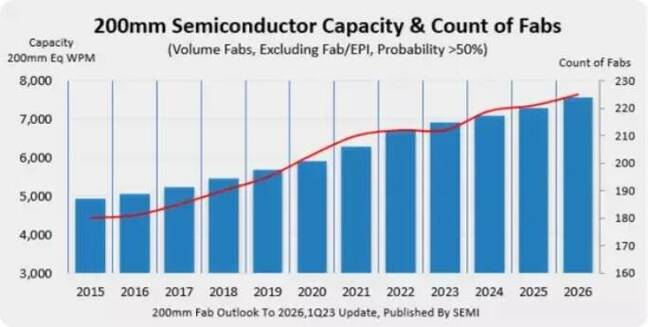A chip off the old block: The 200mm fab supply chain breaker
Southeast Asia, China spearheading factory capacity growth for foreseeable future
There are plenty of reasons to pay close attention to the development and building of 200mm-wafer semiconductor fabs. They give some clear signals about the future of tech supply chains and potential trends in technologies as wide ranging as EVs, computer monitors, consumer devices, sensors, and even large datacenters.
The most common wafer diameter these days is 300mm, with 450mm on the horizon – 200mm was last in vogue in the 1990s. Increasing wafer size means you can fit more – or bigger – chip dies on a single wafer. Upgrading factories to handle larger diameters is expensive and time consuming, let alone building them from scratch, so there is still a need to build fabs for smaller wafers. They strike a balance between cutting-edge capabilities and cost effectiveness.
These fabs handle production of a diverse range of integrated circuits and semiconductor devices, but they also cater to the manufacturing of products where the expenditure of advanced kit cannot be justified – an issue that's more pressing than ever.
From microcontrollers and microprocessors, memory chips, analog chips used in numerous devices including televisions and monitors, to mixed-signal ICs found in nearly all consumer electronics, along with ASICs designed for specific applications, these fabs are producing critical chips.
We should also note such silicon plays a major role in the automotive industry underpinning many modern vehicle functions – from engine control units to airbag systems.
If you want to know what the supply chain looks like across future consumer devices, look at how many such fabs are available.
Luckily, the shortages of the before-times silicon might be a thing of the past – at least for the end user devices mentioned above – if semiconductor analyst experts at SEMI are right.
According to a report issued by the org on Tuesday, semiconductor manufacturers around the globe are expected to boost 200mm-wafer fab capacity by 14 percent between 2023 and 2026.
This increase includes the establishment of 12 high-volume 200mm wafer fabs, and is expected to push the industry to a peak of over 7.7 million wafers per month. All of this, of course, bodes well for broader technology supply chains.
SEMI believes the primary sectors fueling this growth are consumer, automotive, and industrial – particularly thanks to the surge in electric vehicle (EV) adoption and associated increase in demand for powertrain inverters and charging stations.
SEMI's president and CEO, Ajit Manocha, pointed out that the automotive market in particular is experiencing bullish growth expectations, with expansions driven by increased chip content in EVs and initiatives to minimize charging times.
- Make chips, not trade wars, says Semiconductor Industry Association
- Wafer shipments still down, but chipmakers are looking up
- One problem with America's chip ambitions: Not quite enough staff
- Now you've all quit buying RAM and personal gear, chip wafer demand stumbles
Key chip suppliers – such as Bosch, Fuji Electric, Infineon, Mitsubishi, Onsemi, Rohm, STMicroelectronics, and Wolfspeed – are scaling up their 200mm projects to meet anticipated demand.
SEMI expects 34 percent growth in fab capacity for automotive and power semiconductors from 2023 to 2026, with MPU/MCU coming in second with a 21 percent growth, trailed by MEMS, analog, and foundry with respective growth rates of 16 percent, 8 percent, and 8 percent respectively. The primary technologies spearheading the 200mm fab capacity are within the 80nm to 350nm process nodes, anticipating a growth of 10 percent for the 80nm to 130nm nodes and 18 percent for the 131nm to 350nm nodes within the forecast period.
Regionally, Southeast Asia is projected to lead with 32 percent capacity growth, followed by China with 22 percent. Notably, China aims to achieve a production rate of over 1.7 million wafers monthly by 2026.
Following in growth are the Americas, Europe & Mideast, and Taiwan with rates of 14 percent, 11 percent, and 7 percent, respectively. In 2023, China is forecasted to hold a 22 percent share in the 200mm fab capacity, with Japan accounting for 16 percent, trailed by Taiwan, Europe & Mideast, and America with respective shares of 15 percent, 14 percent, and 14 percent.
The global escalation in 200mm fab capacity signals the onset of a more resilient and resource-rich tech supply chain across all relevant sectors. This is welcome news after the chip crises sparked by 2020 events.
If SEMI is proved right, this trend is poised to prevent potential supply bottlenecks and promote a seamless flow in the production pipeline, facilitating a smoother and more efficient supply chain that can only signal better times ahead.
Right? Right. Ahem. ®

 Biting the hand that feeds IT
Biting the hand that feeds IT